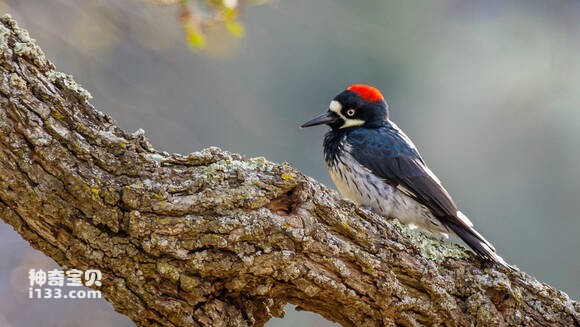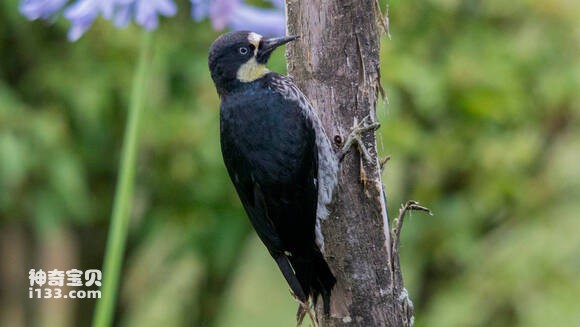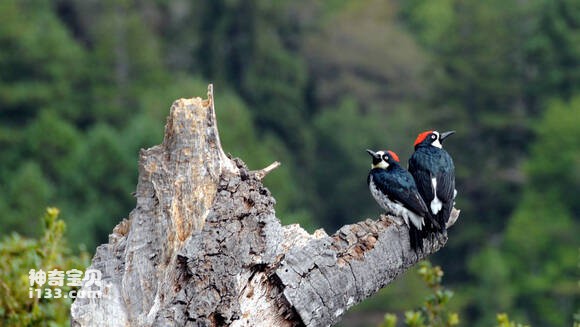Melanerpes formicivorus
IUCN
LCBasic Information
Scientific classification
- name:Melanerpes formicivorus
- Scientific Name:Melanerpes formicivorus,Acorn woodpecker
- Outline:Climbing birds
- Family:
Vital signs
- length:20-23cm
- Weight:No textual research information is available
- lifetime:No textual research information is available
Feature
Distribution and Habitat
Present (resident birds) : Belize, Colombia, Costa Rica, El Salvador, Guatemala, Honduras, Mexico, Nicaragua, and Panama.
Present (breeding grounds) : United States.
Existing and wandering (non-breeding) : Canada.
Adapted to many habitats, including foothills, savannas, riparian woodlands, dense jungles, mixed evergreen forests, low elevation mountain plant communities, and canyon riparian forests.
Appearance
Oak woodpeckers are medium-sized climbers, 20-23 cm long. It has a red crown, a cream white face and a black patch, a gray-yellow forehead, and red on top and back of the neck. The lower larynx, waist and abdomen are white, with thin black longitudinal stripes on the abdomen. The rest of the body is black. Three white patches are shown in flight: one on each wing and one on the hip. Females have fewer red areas on their crowns than males. Legs and feet are dark gray.
The feet are strong, with 4 toes, 2 of which are forward, 2 of which are backward, and the toe ends of each toe have sharp claws, which are skilled in climbing trees. The stem of the tail feathers is stiff like a spine, and can support the tree trunk with its tips, helping the feet to support the weight and climb the tree. The mouth is as stiff as a chisel. The tongue is slender and can be stretched freely, with short hooks at the tip.
Details
Melanerpes formicivorus, Acorn woodpecker, has seven subspecies.

Oak woodpeckers are very unusual woodpeckers that live in large groups and cooperate to hoard acorns. Each team member collected hundreds of acorns and wedged them into small holes cut in tree trunks or telephone poles. They also spend a considerable amount of time catching insects.
Oak woodpeckers are an industrious and united group of birds that usually live in family groups. Each family has several "helper" woodpeckers, who have not yet produced their own offspring, but who spend their days collecting acorns and other food for their chicks. Thousands of acorns are stored each year, and each team member is always vigilant in protecting the hoarded food and preventing small thieves from stealing it.

In the spring after the oak harvest, the average number of new generation birds in the household increased, with each helper woodpecker responsible for an average of about 0.7 more chicks. But during poor harvests, helper birds slightly reduced overall reproductive success.
Oak woodpeckers specifically choose dead trees to store their acorns, and sometimes telephone poles and wooden houses, after which there is basically no complete place. They have a stiff, wedged beak, and spend their days searching, hammering, and burrowing in the woods, hiding acorns in the little holes they pick.

The breeding season for oak woodpeckers is from April to June. Nest in a hole in a tree. The interior is lined with wood chips and dead grass. Each clutch lays 4-6 eggs, and the male and female incubate the eggs in turn. Young birds are late sex.
In a study conducted in California's Santa Clara Valley, oak woodpeckers were sensitive to urbanization due to a lack of mature trees containing borers, and European starlings competed with acorn woodpeckers for tree holes. Oak woodpeckers in the blue oak forests of California's Sacramento Valley are sensitive to tree cutting and pasture expansion. Because these human activities will significantly change their living environment. In southern Arizona and New Mexico, the acorn woodpecker provides hollows for birds such as the chick owl, the purple cliff swallow, the Western Robin, and the purple green tree swallow.
Listed in the International Union for Conservation of Nature Red List of Threatened Species (IUCN) for 2016 ver 3.1 - Not Threatened (LC).
Protect wild animals and eliminate wild meat.
Maintaining ecological balance is everyone's responsibility!








